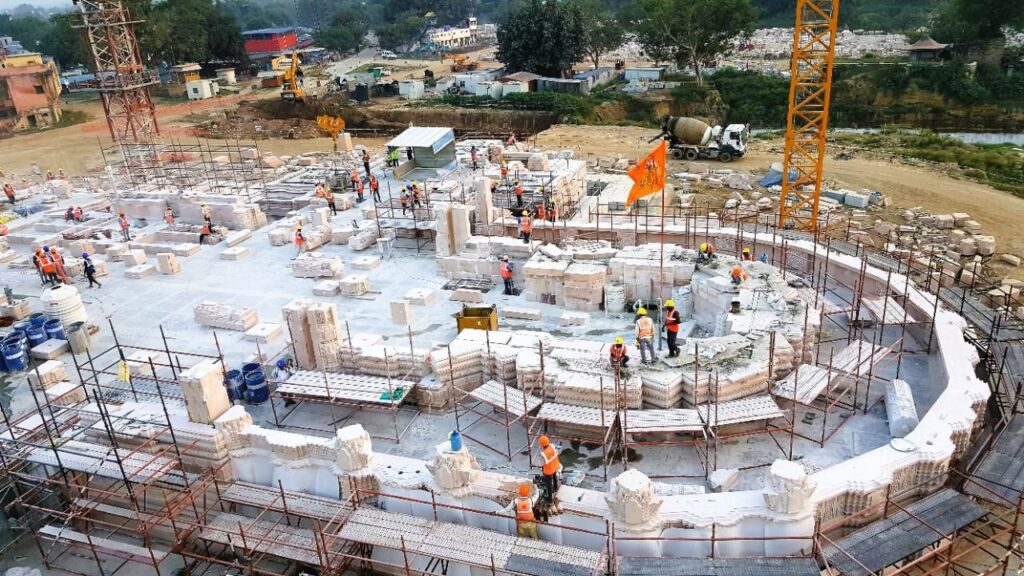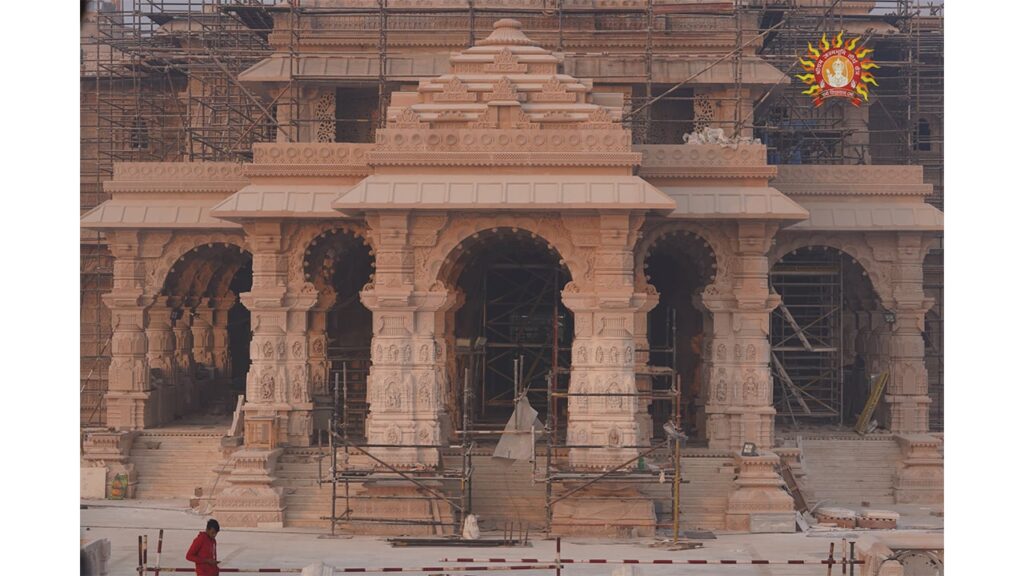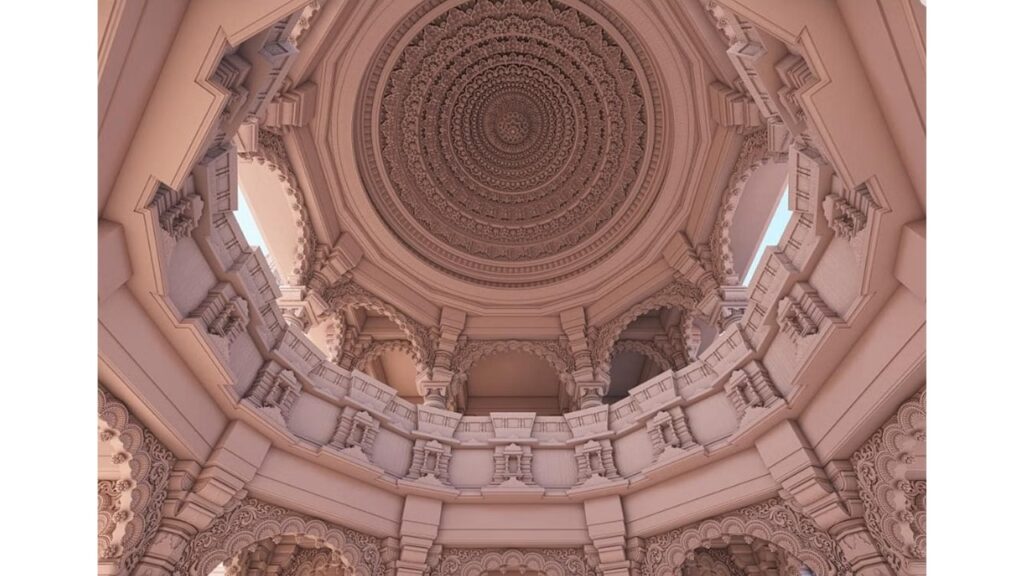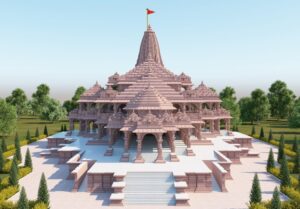India is the spiritual capital of the world because of its diverse culture, religion, tradition, and people. Many people across the world visit India and spend time seeing and living in its beauty. Ram Mandir in Ayodhya is a living testament to the spiritual heritage of India and the enduring legacy of Lord Rama. The mandir holds great significance on this land because it is the birthplace of Shri Ramji. And having a temple there is a great win for their devotees and followers. In terms of religion, culture, and faith, the Ram Mandir is also a great architectural marvel that is situated in Ayodhya, Uttar Pradesh, India. The main temple is designed on the disputed land, which has an area of 2.77 acres. [1] [4]
The temple complex construction is yet to be finished, but some parts of the temple will be inaugurated by our honorable Prime Minister, Shri Narendra Modi, on January 22, 2024. A huge pran-partisha ceremony is conducted to install the Shri Ramji idol in the sanctum-sanctorum (garbha-griha) of the temple. [3] Despite its opening, approximately 50,000+ people visit this temple daily, and after the inauguration, the numbers will go up. [1] When the construction of the whole Ram mandir in Ayodhya is finished, it will be one of the largest Hindu temples in the world.
About this Temple
About this Temple
Ram Mandir is constructed in Ayodhya, Uttar Pradesh, Shree Ramji’s birthplace. Temple is designed in the Māru-Gurjara architecture of Nagara-style architecture. It is a type of Hindu temple architecture often found in the Northern India. This is one of the biggest temples in India, built after independence, and reflects the combination of old Indian traditional architecture and new-age modern architecture. The temple is designed by the architect Chandrakant Sompura and assisted by his two sons, Nikhil Sompura and Ashish Sompura, who are also architects. The original design of the temple was prepared in 1988 by this family only. But later in 2020, some changes were made to it before the initial construction of the temple. The principles of Vastu Shastras and Shilpa Shastras, as per Hindu texts, were also followed while designing the temple. [1] [2]
The built-up area of the main temple is 57400 sq. ft. and the dimensions are length: 380 feet, width: 250 feet, and height (including the peak): 161 feet. The main temple has an area of 2.77 acres, and the whole temple complex has an area of 67 acres with 70% green cover. The temple complex construction is yet to be finished. The 75 to 80% construction of the main temple took 4 years; it was started in 2020 and finished in 2024. [1] [2]. The temple is built with modern prefabrication techniques, and the use of steel, brick, and iron is avoided for the construction [4].
The construction of the temple complex is handled by Larsen & Toubro (L&T). And the whole project is managed by Tata Consultancy Engineers Limited (TCEL). While the design advisors are IIT Guwahati, IIT Chennai, NIT Surat, the National Geo Research Institute, Hyderabad, and others, [3] [4] The estimated construction cost of the Ram Mandir is Rs. 1800 crore. [5]
Structure of the Main temple
Constructing and designing this marvelous structure was never easy, especially with the neglect of the use of steel and iron. Before going with the final design of the ram mandir, ayodhya The architect studies around 550 temples across India so that he can get the best possible design for this temple. A 14-meter-thick layer of roller-compacted concrete looking like artificial rock is used for the foundation of the temple. A 21-feet-high plinth of granite is constructed to protect the temple from ground moisture. The temple has a total of 366 columns and 12 gates; some of the doors are coated with 100 kg of gold. The pillars are decorated with statues, deities, and stone-carved work, which tells the story of Indian history. The main entrance of the temple is called the Singh Dwar. It also features a series of statues and busts of characters from the Ramayana.
Design and Detailing
The temple has three floors, each of 20 feet high. Every floor is designed in such a way that it gives a great experience to the devotees. The ground floor and first floor will have Shri Ramji, Lakshmanji, Sitaji, and Hanumanji idols, and the second floor is added for aesthetic purposes only.
Ground Floor
On the ground floor, a 51-inch-tall Ram Lalla idol in the form of a 5-year-old child will be installed at a height of 8 to 9 feet in such a way that the sun rays fall on the forehead of the Shri Ramji idol. The ground floor is designed in such a way that it depicts the story of the birth and childhood of Shri Ramji. The ground floor also has a parikrama path, and the walkways and columns of it are engraved with 100 events from Valmiki’s Ramayana. The idea is to present the devotees with a Ram Katha Darshan. [1] [4]
First Floor
The first floor of the temple is designed like Lord Rama’s Darbaar. Where idols of Shri Ramji, Sitaji, Lakshmanji, and Hanumanji will be installed (the installation of the idols will still take 8 more months prior to the inauguration ceremony). This floor has a Kirtan Mandap, for peoples to gather and offer mass prayer. [1] [5]
The information on the second floor has yet to be verified.
The main temple consists of a total of five Mandaps: Nritya Mandap, Rang Mandap, Sabha Mandap, Prarthna Mandap, and Kirtan Mandaps. All the mandaps are covered from above. [4] The sanctorum of the mandir would be octagonal-shaped, while the structure perimeter would be circular. [3]
The Temple Complex
The temple is surrounded by the parkota, locally known as the compound wall. The total length of the wall is 732 m, and the width is 4.2 m. The temple complex does not just have a ram mandir; it also has several other religious structures on the four corners of the complex. These four temples are dedicated to Surya Devji, Devi Bhagwati, Shri Ganeshji, and Lord Shivji. The northern and southern arms also have temples of Maa Annapurna and Lord Hanumanji.
Some of the other proposed temples in this temple complex are Maharishi Vashishtha, Maharishi Valmiki, Maharishi Vishwamitra, Maharishi Agastya, Nishad Raj, Devi Ahilya, and Mata Shabri.
A historic well, “Sita Koop,” is located near the temple and will take you back to the ancient era. [4]
Some other proposed structure in the temple complex are:
- Shri Ram Kund: Yagyashala (Home of Holy Offering)
- Karm Kshetra: Anusthaan Mandap (House of Holy rituals)
- Hanuman Gadhi: Veer Maruti Vishal Pratima (Gigantic Statue of Lord Hanumanji)
- Shri Ramlala Purakalik Darshan Mandal: Janambhoomi Sangrahaley (Display of archaeological and historical relic found during excavation)
- Shri Kamm Keerti: Satsang Bhavan Sabhagaar (a place for discourse and mass prayer)
- Bhakti Teela: Special zone for deeper meditation
- Tulsi: Ramlila Center, 360 degree theater
- Ramayan: Reading room and library
- Ramashrayam: Multistoried Boarding, Waiting lounge, and lodging facilities
- Shri Dashrath: Shelter for cows
- Laxman Vatika: Lily pond and Musical Fountain
- Lav Kush Nikunj: Activities areas for kids and adults.
- Maryada Khand: Special guests residential area
- And several others. [1]
Materials used for the construction
For the construction of Ram Mandir, the use of stone and iron was neglected. Instead of these, traditional construction materials are used to reflect an alignment with traditional building practices while also focusing on sustainability.
- A total of approximately 6,00,00 cu ft (17000 m3 ) pink sandstone from Baansi in Rajasthan is used for stonework. This is the same stone which has been used in various buildings in India.
- Granite stone from Telangana for the plinth work.
- White Makrana and colored marbles for inlay work.
- Teakwood (Sagwan) from Maharashtra for the doors and windows of the temple.
- Copper plates for the joinery works.
- Shaligram Rock, Gold, and Ashtdhatu materials are also used for the construction work. [4] [2]
Key features and Facts about this temple
- Entry is from the east, ascending 32 stairs through the Singh Dwar.
- Provision of ramps and lifts for the convenience of the differently-abled and elderly.
- The structure of the temple is earthquake-resistant, and the estimated age of the temple is 2000 to 2500 years.
- The idols installed in the temple are made from the 60 million-year-old Shaligram Rocks, brought here from the Gandaki River, Nepal.
- A huge bell is installed in the temple, made up of Ashtadhatu (a combination of gold, silver, copper, zinc, lead, tin, iron, and mercury), and the weight of the bell is approximately 2100 kg. It is brought from Etah and has dimensions of 5 feet by 6 feet. The sound of the bell can be heard from a distance of 15 km.
- This temple complex is built to welcome over 1,00,000 devotees at a time. Currently, every day, 50,000 devotees visit the temple.
- The construction of this mandir was taken into consideration in terms of sustainable design. It has its own water treatment plant, sewage treatment plant, power station, use of stone as construction material, 70% of green cover and others. [4] [1] [3]
About the Architect of Ram Mandir, Ayodhya
The temple was designed by the architect, Chandrakant Bhai Sompura. He was appointed to design the Ram Mandir in 1988. For the master plan, he measured the area of the temple with his footsteps. He devoted himself to the great design of Ram Mandir and studied over 550 temple plans in India to design the best architectural design for Ram Mandir. He was assisted by his two sons, architects Nikhil Sompura and Ashish Sompura.
The Sompura family has designed approximately 100 temples around the world over the course of at least 15 generations. His grandfather, Prabhakarji Sompura, designed the Somnath Temple in Gujarat. [2] [3]
Organization behind the construction of Ram Mandir
After the final verdict of the Supreme Court, it was ordered that the land should be given to a trust that will be responsible for the construction of Ram Mandir. Then the government of India formed a trust named “Shri Ram Janmbhoomi Teerth Kshetra Trust (SRJBTKshetra) on February 5, 2020. The trust took on the responsibility of the construction and management of Ram Mandir in Ayodhya and constructed the main temple in just 4 years. The whole temple complex construction will soon be finished. [1]
Location and Visitor Guidelines
The exact location of the Ram Mandir is “Sai Nagar, Ayodhya, Uttar Pradesh 224123”. It is accessible from every possible transportation service.
The mandir is open for devotees every day from 7am to 11:30am and 2pm to 7pm. To read more about ram mandir, ayodhya new updates, visitors guidelines, daily rituals, and other important information, click here
Why was the construction of the Ram Mandir in Ayodhya important?
As Hindus, we should not be justifying the significance of Ram Mandir at his birth place. Shri Ramji is our divine god and the seventh incarnation of Lord Vishnuji. Having a temple in his birthplace is a blessing for us. It was our dream for many years, and finally, when the Supreme Court verdict came in our favor, we didn’t have words to describe our happiness. Apart from the religious sentiments, the temple standing tall at Ayodhya has several other important aspects:
- Religious Significance: The construction of Ram Mandir at his birth place Ayodhya ended the long-standing dispute between Hindus and Muslims and brought peace between them.
- Historical and Cultural Significance: The temple’s structure is intended to restore and preserve Ayodhya’s historical and cultural heritage. The temple displays traditional Hindu architecture and artistry, adding to India’s diverse cultural heritage.
- Symbol and National Unity: The temple will stand as a symbol for many people and for our nation, as it brought various sections of society together through their participation and contribution in the construction.
- Economic Impact: Because of the Ram Mandir, the economy of the Ayodhya and surrounding areas will increase as it will bring job opportunities and employment there.
- Infrastructural Development: Due to Ram Mandir, the infrastructure around the Ayodhya region will increase and attract various megaprojects like roads, rail, airports, industries, etc.
- International Recognition: The construction of the Ram Mandir garnered attention and recognition on the international stage, symbolizing the religious and cultural diversity of India.















